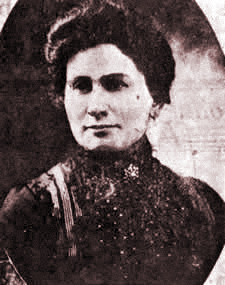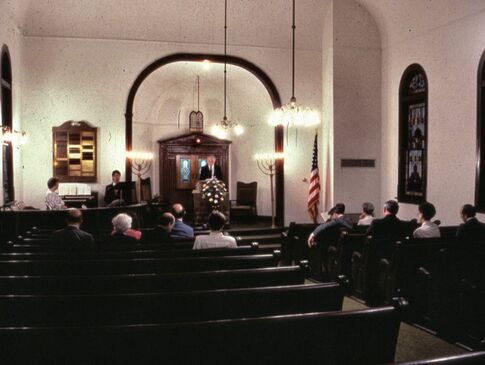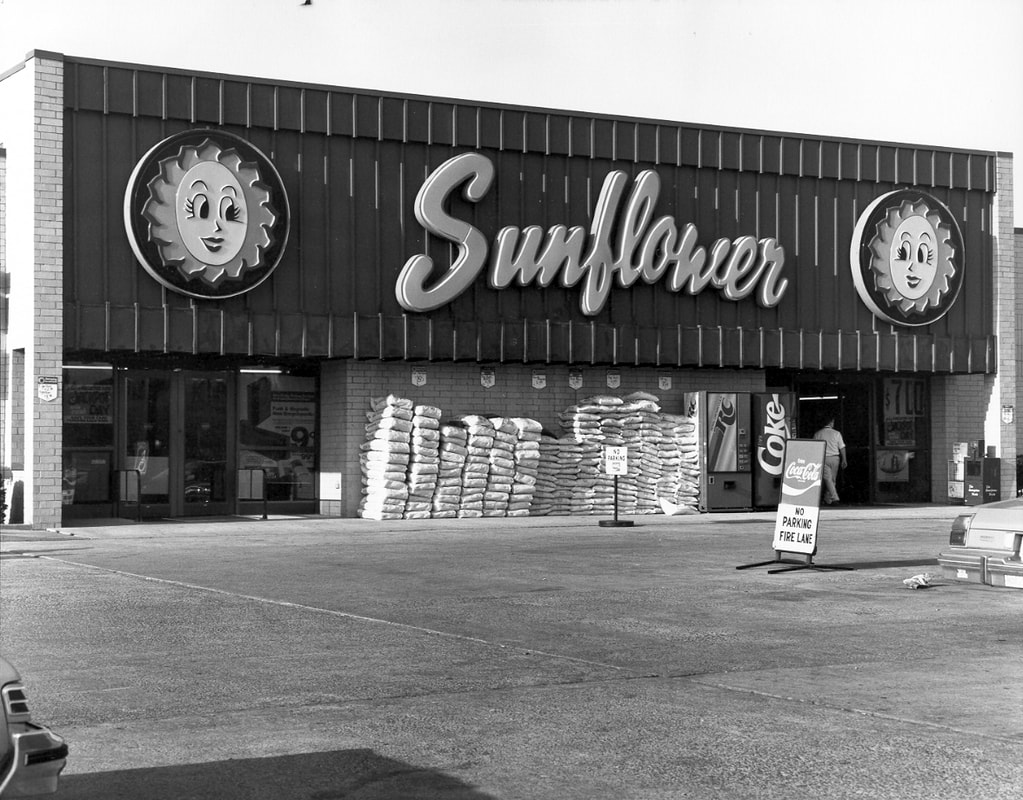Encyclopedia of Southern Jewish Communities - Lexington, Mississippi
Overview >> Mississippi >> Lexington
Overview
Lexington, the seat of Holmes County, once served as a bustling commercial hub for the nearby countryside. The town sits in the rolling Loess Hills that run along the eastern border of the Mississippi Delta, and, while Lexington is geologically separated from the Delta by about ten miles, its history and culture mirror small market towns in the Delta region. When Lexington was established prior to the Civil War, Holmes County was home to a small, majority-enslaved population. During and after Reconstruction, the area attracted large numbers of Black, formerly enslaved agricultural workers, most of whom grew cotton as tenant farmers or sharecroppers. By the mid-20th century both Lexington and Holmes County began a period of declining population, due to agricultural mechanization and economic challenges.
Jewish settlers arrived in Lexington by the mid-1840s and soon became involved with the local cotton economy and in retail trade. After the Jewish population increased in the late 19th century, local Jews established a congregation, Temple Beth El, in 1905. The small congregation remained active into the early 21st century, when it finally closed after decades of decline in the local Jewish population.
Jewish settlers arrived in Lexington by the mid-1840s and soon became involved with the local cotton economy and in retail trade. After the Jewish population increased in the late 19th century, local Jews established a congregation, Temple Beth El, in 1905. The small congregation remained active into the early 21st century, when it finally closed after decades of decline in the local Jewish population.
Early Jewish Settlers
The town of Lexington incorporated in 1836, and Jewish immigrants arrived in the area within the next decade or so. Jacob Sontheimer of Germany first came to Holmes County in the 1840s, where he worked as a peddler before opening a general merchandise business in a brick building on the courthouse square in Lexington. In the 1850s Sontheimer extended a significant amount of credit to an elderly plantation owner, Mr. Johnson, and Sontheimer ultimately inherited Johnson’s land upon his death in 1856. (The Johnson family sued over the disposition of the enslaved workers who worked the farm, and Sontheimer fought to retain ownership.) At the outbreak of the Civil War, Jacob Sontheimer owned 1,200 acres, known as Sontheimer’s place, a name that persisted even after the family sold the land. According to the 1860 U.S. Census Slave Schedules, Sontheimer enslaved fourteen African Americans—a small number for such a large property—so he likely rented land to farmers or paid other slave owners for the labor of enslaved workers. While Jacob and his wife Mary were quite successful, the Civil War decimated the Sontheimer ventures, and he never reached his earlier level of success.
 Bettie Sontheimer Fisher
Bettie Sontheimer Fisher
In the aftermath of the Civil War, the Sontheimer family (or at least some family members) left Lexington for several years, but they returned in the early 1870s. In 1883 Jacob and Mary’s daughters Rose and Bettie established R. & B. Sontheimer Company, which furnished goods for sharecroppers through the crop-lien system. This was a profitable business in the cotton-dominated economy of Holmes County, where the Black population had grown from slightly fewer than 12,000 individuals in 1860 to more than 20,000 in 1880, and where an additional 8,000 Black residents lived by 1900. Black residents, who accounted for more than three-quarters of the county’s population, had few work opportunities outside of agriculture and domestic labor, and only a small minority of Black farmers owned their own land.
Rosa and Bettie’s business proved lucrative, and Rosa became notably wealthy, especially for a single woman in 19th-century Mississippi. She eventually married Isadore Hyman of Greenwood, who joined the business. Over time Rosa and Isadore Hyman amassed nearly 4,000 acres of land, either through purchases or as repayment for debt. The Sontheimer and Hyman families’ successes mirrored stories of Jewish business people elsewhere in the late-19th-century South whose commercial activities diversified from merchandising to land ownership and agricultural industries as they accumulated capital. Additionally, the personal ups and downs that Jacob Sontheimer experienced reflect the turbulence of the period, just as his families’ repeated migrations demonstrate the high mobility of American Jews at the time.
Rosa and Bettie’s business proved lucrative, and Rosa became notably wealthy, especially for a single woman in 19th-century Mississippi. She eventually married Isadore Hyman of Greenwood, who joined the business. Over time Rosa and Isadore Hyman amassed nearly 4,000 acres of land, either through purchases or as repayment for debt. The Sontheimer and Hyman families’ successes mirrored stories of Jewish business people elsewhere in the late-19th-century South whose commercial activities diversified from merchandising to land ownership and agricultural industries as they accumulated capital. Additionally, the personal ups and downs that Jacob Sontheimer experienced reflect the turbulence of the period, just as his families’ repeated migrations demonstrate the high mobility of American Jews at the time.
A Growing Jewish Community
At the end of the 1870s around 20 Jewish individuals lived in Lexington. Like the Sontheimers, most had immigrated from Germany. By the 1890s, additional Jewish migrants found their way to Lexington and the surrounding area from Poland and Russia. Some new arrivals also came from elsewhere in the United States. As a result, Lexington’s Jewish population reached fifty people by the turn of the century.
Jewish newcomers generally made their livings in trade, whether they dealt in dry goods, groceries, or readymade clothing. Isaac Flowers, a tailor from Poland, and his wife, Esther, came to Holmes County and opened a clothing business in 1881. It is possible that the Flowers family, who had roots in Kolo, Poland, had a prior connection to the family of Isadore Hyman, who was born not far away. Another late-19th-century arrival, Morris Lewis, came from Lipno, Poland, which is in the same general area. Genealogical research by Lewis’s descendants suggests that his migration to Lexinton was influenced by old country relationships to the Flowers and Hyman families, as well as to interconnected families who settled elsewhere in Mississippi, Louisiana, and Texas.
Morris Lewis originally immigrated to New York City with his family at 13 years old. A few years later, in 1890, he joined his aunt Regina Goldstein Hyman in Sidon, Mississippi, a small town south of Greenwood. After working as a clerk in his uncle’s store, Lewis relocated to Lexington, where went into business with Sam Herrman in 1895 and subsequently married Sam’s sister Julia (granddaughter of Jacob Sontheimer) in 1899. The Lewis-Herrman Company expanded during the first two decades of the twentieth century, in part through mergers with other grocers. In 1922 Morris Lewis established Lewis Grocer Company, which served as a wholesale distributor and ultimately operated a chain of retail grocery stores under the name Sunflower Food Stores. In 1933 the company moved its headquarters to Indianola and later merged with Supervalu, a national wholesaler based in Minneapolis. Morris Lewis’s son, Morris Lewis Jr. eventually served as CEO of Supervalu.
Jewish newcomers generally made their livings in trade, whether they dealt in dry goods, groceries, or readymade clothing. Isaac Flowers, a tailor from Poland, and his wife, Esther, came to Holmes County and opened a clothing business in 1881. It is possible that the Flowers family, who had roots in Kolo, Poland, had a prior connection to the family of Isadore Hyman, who was born not far away. Another late-19th-century arrival, Morris Lewis, came from Lipno, Poland, which is in the same general area. Genealogical research by Lewis’s descendants suggests that his migration to Lexinton was influenced by old country relationships to the Flowers and Hyman families, as well as to interconnected families who settled elsewhere in Mississippi, Louisiana, and Texas.
Morris Lewis originally immigrated to New York City with his family at 13 years old. A few years later, in 1890, he joined his aunt Regina Goldstein Hyman in Sidon, Mississippi, a small town south of Greenwood. After working as a clerk in his uncle’s store, Lewis relocated to Lexington, where went into business with Sam Herrman in 1895 and subsequently married Sam’s sister Julia (granddaughter of Jacob Sontheimer) in 1899. The Lewis-Herrman Company expanded during the first two decades of the twentieth century, in part through mergers with other grocers. In 1922 Morris Lewis established Lewis Grocer Company, which served as a wholesale distributor and ultimately operated a chain of retail grocery stores under the name Sunflower Food Stores. In 1933 the company moved its headquarters to Indianola and later merged with Supervalu, a national wholesaler based in Minneapolis. Morris Lewis’s son, Morris Lewis Jr. eventually served as CEO of Supervalu.
While the Lewis and Herrman families accomplished much for themselves, their success brought industrial development and civic improvements to Lexington. They either established or helped to develop a cotton press, an ice factory, a cotton oil mill, a waterworks system, and a sewage system to Lexington. Morris Lewis helped found the Lexington Rotary Club and served as the first chairman of the board of the hospital in Holmes County. He organized the first electric light company as well as Merchants & Farmers Trust Company of Holmes County.
Jewish Life in Lexington
By the time that Morris Lewis and Sam Herrman arrived in Lexington, the area had attracted enough Jews to form the beginnings of a religious community. In the 1890s members of the Sontheimer and Hyman families met for services in the home of Henry Rosenthal, who also led the prayers. As the Jewish population grew, local families conducted High Holiday services at the Lexington Opera House. Lena Levy and Julia Cohen organized the first Sunday school in 1901. A year later, local Jews hired Rabbi Abram Brill of Hebrew Union Congregation in Greenville, Mississippi, to conduct monthly services in Lexington.
The Jewish community of Lexington established a cemetery in 1904. In that same year, Rabbi Brill convinced the local Jews to form Temple Beth El (House of God), and the congregation immediately affiliated itself with the Reform movement. Morris Lewis and Sam Herrman purchased the lot where the temple stood. To raise funds for the building Lena Levy organized a group to perform at the Lexington Opera House. Most of the cast were members of the Baptist church. Additional donations came from members of Lexington’s Jewish community. In November of 1905, Temple Beth El’s 30 members dedicated their first synagogue on Spring Street, a small frame structure with an entrance hall, two small classrooms on either side of the front entrance, and a sanctuary. The sanctuary took up most of the synagogue’s interior. For many years, the modest building had no bathroom, and worshippers had to use the facilities at San and Flora Herrman's home across the street.
Temple Beth El claimed 15 member families and twenty religious school students three years after the founding of the congregation. In keeping with Reform tradition at the time, services were conducted almost entirely in English. They also held religious services on Sundays, which accommodated the schedules of local Jewish merchants (whose busiest business days were Saturdays) as well as visiting rabbis. Temple Beth El never employed a full-time clergy person and relied on visiting rabbis, student rabbis, and congregants to lead worship and teach religious school.
Temple Beth El claimed 15 member families and twenty religious school students three years after the founding of the congregation. In keeping with Reform tradition at the time, services were conducted almost entirely in English. They also held religious services on Sundays, which accommodated the schedules of local Jewish merchants (whose busiest business days were Saturdays) as well as visiting rabbis. Temple Beth El never employed a full-time clergy person and relied on visiting rabbis, student rabbis, and congregants to lead worship and teach religious school.
A Small but Tenacious Community
 A worship service at Temple Beth El, c. 1990. Photo by Bill Aron.
A worship service at Temple Beth El, c. 1990. Photo by Bill Aron.
The local Jewish population peaked around 1930. In 1927 Lexington had 80 Jewish residents, and Temple Beth El confirmed its largest group of students (thirteen confirmands) in 1929. The Great Depression initiated a decline in local Jewish numbers that continued for decades as a confluence of factors decreased the viability of Jewish retail businesses. Nevertheless, Temple Beth El supported an active sisterhood (named for Julia Herrman Lewis) and a local B'nai Brith chapter (named for Isadore Hyman). For many years, students from Hebrew Union College, America’s seminary of Reform Judaism, conducted High Holiday services, and afterwards, congregants ate dinner at the mansion of Morris Sr. and Julia Lewis. Vicksburg rabbis served the congregation on a monthly basis from the 1910s until the 1950s, when Rabbi Perry Nussbaum of Jackson’s Beth Israel Congregation took over the pulpit. Rabbi Nussbaum initially led Sunday evening services, but these were rescheduled for Wednesday evenings (a popular night for Christian prayer meetings) sometime around 1960. The congregation also maintained its small religious school in the postwar decades, and it continued to draw members from Pickens, Indianola, and other nearby towns. Rabbi Nussbaum was succeeded by Rabbi Alan Schwartzman of Vicksburg, followed by Rabbis Eric Gurvis, Steven Engle, Jim Egolf, and Valerie Cohen, all hailing from Jackson. Henry Paris of Indianola led High Holiday services from the 1970s until the synagogue’s closure in the early 21st century.
Despite Temple Beth El’s small size, two Lexington natives made significant contributions to the Reform movement’s rabbinical school, Hebrew Union College. Cecil (1913-1994) and Gus (1920-2001) Herrman grew up in the congregation. Their father, Morris Herrman was a brother of Sam Herrman and worked for the Lewis-Herrman Company. Although Cecil and Gus led unassuming lives, they had each inherited stock in the Lewis Grocer Company from their father, which (along with other investments) accrued value over the decades. According to a family story, they had befriended longtime Memphis Rabbi James Wax when he was a student rabbi visiting Lexington in the late 1940s. At a High Holiday dinner, Wax had casually mentioned to the family that, if they were ever in a position to do so, they should consider donating money to Hebrew Union College, which educates Reform Rabbis and supplies student rabbis to small congregations. His comment evidently made an impression. The two brothers, neither of whom married or had children, each bequeathed the bulk of his estate to college. The unsolicited and unconditional donations amounted to more than 10 million dollars, and the Cincinnati campus’s primary educational building was renamed the Cecil Herrman Learning Center.
When Temple Beth El celebrated its centennial in 2005, Hebrew Union College Jewish Institute of Religion president Rabbi David Ellison addressed an audience of local Jews, former members who had relocated, and family and friends. Descendants of the Hyman family donated a stained glass Star of David which was installed above the front entry. (Prior to that time the building was not outwardly Jewish.) While the centennial served as a celebration, it was clear by then that the congregation would have to permanently close its doors before long. Membership had dropped to a dozen individuals, and only one Jewish store remained on the town square.
In 2009, the congregation held its final services for Yom Kippur. Cohen’s, the last Jewish retail establishment in Lexington, remained open until 2017. Phil Cohen, whose grandfather had moved the shop from nearby Tchula to Lexington in 1912, regretted closing the store but was ready to enjoy retirement. In 2020 the Lexington Odd Fellows Cemetery assumed maintenance responsibilities for the Temple Beth El cemetery. The Jewish cemetery lies within the Odd Fellows Cemetery boundaries but was separately owned. The agreement between the two cemeteries will ensure perpetual care for Lexington’s Jewish burial site. As of 2022 the former synagogue building and the cemetery remain as testaments to the smallest Mississippi Jewish community to persist for more than a century.
When Temple Beth El celebrated its centennial in 2005, Hebrew Union College Jewish Institute of Religion president Rabbi David Ellison addressed an audience of local Jews, former members who had relocated, and family and friends. Descendants of the Hyman family donated a stained glass Star of David which was installed above the front entry. (Prior to that time the building was not outwardly Jewish.) While the centennial served as a celebration, it was clear by then that the congregation would have to permanently close its doors before long. Membership had dropped to a dozen individuals, and only one Jewish store remained on the town square.
In 2009, the congregation held its final services for Yom Kippur. Cohen’s, the last Jewish retail establishment in Lexington, remained open until 2017. Phil Cohen, whose grandfather had moved the shop from nearby Tchula to Lexington in 1912, regretted closing the store but was ready to enjoy retirement. In 2020 the Lexington Odd Fellows Cemetery assumed maintenance responsibilities for the Temple Beth El cemetery. The Jewish cemetery lies within the Odd Fellows Cemetery boundaries but was separately owned. The agreement between the two cemeteries will ensure perpetual care for Lexington’s Jewish burial site. As of 2022 the former synagogue building and the cemetery remain as testaments to the smallest Mississippi Jewish community to persist for more than a century.
The ISJL would like to acknowledge the assistance of Morris Lewis IV and Adam Lewis, whose genealogical and historical research helped to improve the Lexington, Mississippi, entry.
Selected Bibliography
Robert Lewis Berman, A House of David in the Land of Jesus, (self-published, 2007).
Leo E. Turitz and Evelyn Turitz, Jews in Early Mississippi (Jackson: University Press of Mississippi, 1983.
Robert Lewis Berman, A House of David in the Land of Jesus, (self-published, 2007).
Leo E. Turitz and Evelyn Turitz, Jews in Early Mississippi (Jackson: University Press of Mississippi, 1983.

